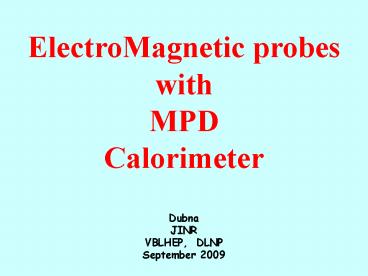ElectroMagnetic probes - PowerPoint PPT Presentation
1 / 33
Title:
ElectroMagnetic probes
Description:
They are not distorted by final state interactions and once produced can escape ... invariant mass spectrum measured by CERES (left) and PHENIX (right) ... – PowerPoint PPT presentation
Number of Views:36
Avg rating:3.0/5.0
Title: ElectroMagnetic probes
1
ElectroMagnetic probes with MPD Calorimeter
Dubna JINR VBLHEP, DLNP September 2009
2
- 1. Physical motivations
- Electromagnetic probes
- Particle rate
- 2. Requirements to the Ecal
- 3. Performance
- 4. Prototype status
- 5. Electron identification
- 6.Conclusions
3
Electromagnetic Probes virtual (appearing as
ee- or µµ- pairs) real photons are tools
to diagnose the hot and dense matter produced in
relativistic heavy-ion collisions.
They are not distorted by final state
interactions and once produced can escape
unaffected the interaction region, carrying to
the detectors information about the conditions
and properties of the medium at the time of their
creation.
4
- thermal radiation emitted by the strongly
interacting Quark-Gluon Plasma - in the early phase of the collision. The
elementary processes involved are - annihilation
- QCD Compton
- identification of this signal ?
- 1. proof of deconfined phase
- 2. direct measurement the temperature, readily
given by the inverse slope. - Theory has singled out the thermal radiation from
the - Quark-Gluon Plasma phase
- .
5
b) Thermal radiation emitted by the high-density
hadron gas in the later phase of the collision.
The main elementary process here is the pion
annihilation , mediated through vector meson
dominance. This component, controlled by the
pole at the rho mass of the pion electromagnetic
form factor, contributes primarily to the
low-mass region, around and below the ? mass.
6
- There are two main difficulties in the
experimental measurements - Huge combinatorial background of uncorrelated
lepton pairs. - This background therefore depends quadratically
on the particle multiplicity and - strongly increases as the coverage moves to
low-pT leptons. - In the measurement of ee- pairs, p Dalitz
decays and conversions. - Physics background.
- Photons and dileptons can be emitted by a
variety of sources and - therefore before claiming observation of any new
effect, it is mandatory - to have a thorough understanding of the expected
contribution - from all known sources.
- Gammas created due to electromagnetic decays of
hadrons after - the freeze-out carry no information about excited
system and - should be subtracted.
7
PHENIX
The fraction of the direct photon component as a
function of Pt in (a) pp and (b) AuAu (min.
bias) at vS 200 GeV. The error bars and the
error band represent the statistical and
systematic uncertainties, respectively. The
curves are from a NLO pQCD calculation.
8
Low mass enhancement seen in AuAu invariant mass
spectrum measured by CERES (left) and
PHENIX (right)
9
Anomaly observed in energy dependence for the
K/p ratio Systematical uncertainty can be
reduced by involving K/p or K/? ratio in the
analisys
10
Phase transition should be indicated by increase
in photon activity p rate vs beam energy? ?
rate vs beam energy? Prompt ? rate vs beam
energy?
AuAu collisions at vSNN9GeV UrQMD
Photons associated to the p
100/Pt 50/Pt 20/Pt 10/Pt 5/Pt
N? /Np
Np/Np
N? pr /Np
Pt(GeV)
Pt(GeV)
11
Requirements to the Ecal
Energy spectra and multiplicity distribution are
determine lateral and longitudinal size of
calorimeter cell
AuAu collisions at vSNN9GeV UrQMD
12
Calorimeter energy resolution strongly determine
psignal to combinatorial background ratio and
resolution in the ?? invariant mass spectra
13
Main option Shashlyk type of calorimeter
KOPIO
14
Granularity -3x3 cm
AuAu collisions at vSNN9GeV
15
(No Transcript)
16
(No Transcript)
17
(No Transcript)
18
(No Transcript)
19
p
20
(No Transcript)
21
(No Transcript)
22
Energy resolution (2.90.1)/vE(GeV). Time
resolution (8010)psec / vE(GeV).
23
(No Transcript)
24
(No Transcript)
25
(No Transcript)
26
Detector response vs beam energy
27
MIP
28
(No Transcript)
29
(No Transcript)
30
(No Transcript)
31
(No Transcript)
32
- Conclusions
- Wide range of physics tasks can be studied
- including ECal into the MPD detector
- Proposed "SHASHLYK" type of calorimeter is
adequate to the physics tasks - Prototype of calorimeter module has been built
and tested with CERN and DESY beams. - Expected parameters have been reached.
33
(No Transcript)































